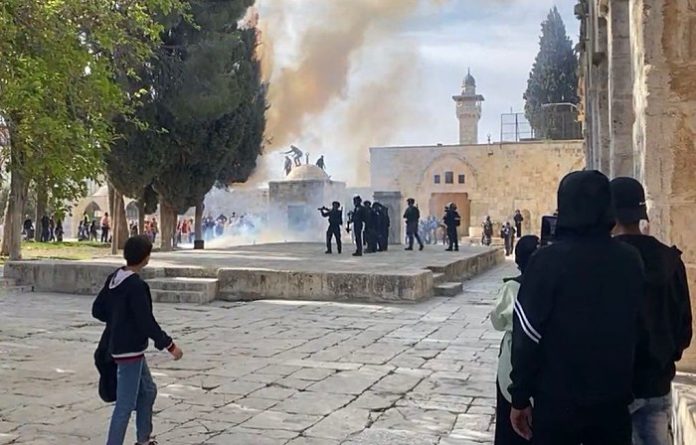JERUSALEM (VINnews) — The month of Ramadan varies annually as the Muslim lunar calendar does not have a leap year to keep up with the solar calendar. This year the month coincided with Nissan, a time when Jews hope and pray that the redemption from Egypt will presage a renewed redemption from the nations of the world. The Pesach festival marks the exodus from Egypt and many people flock to the Kotel, the Western Wall of Temple Mount, to pour forth their supplications for a speedy restoration of the Jewish people to its former glory.
Join our WhatsApp groupSubscribe to our Daily Roundup Email
Yet even before reaching the Kotel, many visitors this year were in for a rude shock as Arab hooligans, incited daily by their imams to preserve their holy places from the infidels, attacked Jews on a number of occasions. Miraculously the Arab attacks, including stonethrowing at buses travelling to the Kotel and setting upon Jews in taleisim[prayer shawls] walking through the Muslim Quarter, ended in minor injuries. However they served to deter many people from making a pilgrimage to the Kotel.
A determined response by right-wing Israelis would have included a march through Damascus Gate by thousands of Israelis in a show of solidarity with Jews walking to the Kotel but police, fearing violent reactions to the march, nixed it. Thus the Arab aggression and the meek Israeli response (arrest the suspects and let the incitement go on) led to a feeling of uncertainty and anxiety on the Jewish side and belligerent rhetoric from Arabs against Jews ascending Temple Mount. Predictably, the government closed Temple Mount for the last two weeks of Ramadan – yet another concession to terror.
As a Jerusalemite, it was important for me to at least reach the Kotel during Pesach and demonstrate that I would not be cowed into submission by the Muslim threats. Despite Damascus Gate being the closest route to the Kotel, I did not feel secure enough to traverse the Muslim quarter on a Friday and chose the more conventional Jaffa Gate route. The Kotel was as usual a mass of eclectic different forms of prayer and I joined an Ashkenazi minyan in the open plaza.
As we sang the Hallel prayer, we heard a commotion above on Temple Mount. Suddenly shots rang out, presumably rubber bullets being shot by police in response to fireworks and stonethrowing. A few moments later, smoke started billowing over the Kotel from above and ashes started raining on our heads, covering the plaza with soot. We hurriedly covered the Sifrei Torah and ran for cover. Apparently a firework had set a tree on fire and the resulting blaze had caused the ashes to spray on the Kotel but the symbolism did not escape us. As we prayed for a final redemption, we were being showered with the very symbols of the destruction of the Temple – from the place of the Temple.
משעות הבוקר ממשיכות הפרות הסדר בשטח הר הבית כשעשרות רעולי פנים מיידים אבנים ויורים זיקוקים. מפרי הסדר ומיידי האבנים פוגעים בראש ובראשונה במתפללים הרבים שנמצאים בהר הבית. יש לציין שהיו ניסיונות של חלק מאותם מתפללים להפסיק את הפרות הסדר וידויי האבנים ולהרחיק את פורעי החוק שלא צלחו. pic.twitter.com/oNbh8Y7GAY
— משרד החוץ (@IsraelHebrew) April 22, 2022
View from Temple Mount of rioters, 4.22.22
There was however one consolation in the situation. Jews are prohibited from planting trees on Temple Mount and must uproot trees from the holy place. In the current situation this is not possible but at least we had the satisfaction of knowing that the Arabs themselves had burnt one of the trees at the site.


My 2 cents:
When the Bnai Yisroel committed the aveira of the Miraglim, Moshe Rabbeinu told them that they would now have to wait an additional 40 years to enter Eretz Yisroel. Some of the Bnai Yisroel insisted they could take the land now, and not need to wait the additional 40 years. Moshe warned them that Hashem would not be with them and they would be doomed. The Torah tells us that the Jews who tried to enter the land were clobbered by the Canaanites. Without Hashem’s bracha, Jews had no right to enter the land.
Today, we are in Golus. We will remain in Golus until Hashed decides to deliver us. Being in Golus means that we will not have certain privileges that we enjoyed when the Bais Hamikdosh stood. One of those privileges is our ability to enter the Har Habayis. We had the Har Habayis and then lost it due to our aveiros. We cannot force ourselves back onto it. If we try the occupying enemy will fight us. We need to wait until such time that Hashem sees fit to redeem us and let us back onto the Har Habayis. Maybe seeing it in the hands of the Muslims will spur us on to do tshuva and hasten the days of Moshiach.
What a mess, HASHEM please bring us clarity.